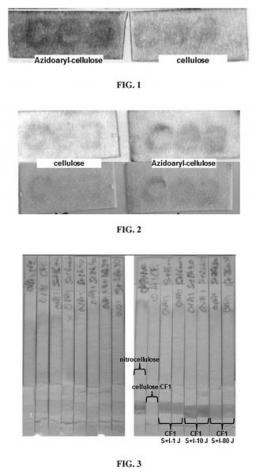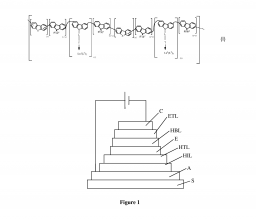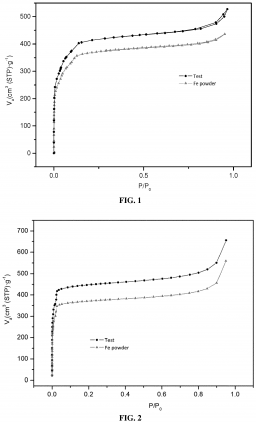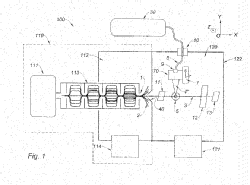Brevets 2015
Numéro d’identification : WO/2015/150588 (lien OMPI)
Numéro d’identification CEA BD
Année de dépôt : 03-04-2014
Date de publication : 08.10.2015
Nouveaux complexes pour la séparation de cations
L'invention concerne des complexes comprenant un support solide et un matériau à structure matricielle comportant des domaines complexant des terres rares ou des métaux stratégiques, leur procédé de préparation, et leur utilisation pour extraire ou séparer les terres rares ou les métaux stratégiques dans un milieu aqueux ou organique.
Contact CEA : P. Viel (NIMBE/LICSEN).
Novel complexes for the separation of cations (WIPO link)
The invention relates to complexes comprising a solid support and a material with a matrix structure comprising domains complexing rare earths or strategic metals. The invention also relates to the method for the production of said complexes and to the use thereof for extracting or separating the rare earths or the strategic metals in an aqueous or organic medium.
CEA contact: P. Viel (NIMBE/LICSEN).
Numéro d’identification: WO/2015/132350 (lien OMPI)
Numéro d’identification CEA BD15700
Année de dépôt : 05-03-2014
Date de publication : 11-09.2015
Procédé de photo-immobilisation de biomolécules sur un support non fonctionnalisé
L’invention concerne l'immobilisation de biomolécules sur un support non fonctionnalisé, par exposition du support imprégné de biomolécules à une lumière d'une longueur d'onde d'au moins 340 nm..
Contact CEA : T. Berthelot (NIMBE/LICSEN).
Method for photo-immobilizing biomolecules on a non-functionalized carrier (WIPO link)
The invention relates to the immobilization of biomolecules on a non- functionalized carrier by irradiating the biomolecule-impregnated carrier with a light of a wavelength of at least 340 nm.
Contact CEA : T. Berthelot (NIMBE/LICSEN).
Numéro d’identification international : WO/2014/122206 (lien OMPI)
Numéro d’identification CEA : BD 14279
Date de dépôt : 07-02-2013
Date de publication: 14-08-2014
Nouveaux metallopolymeres et leur utilisation
L'invention concerne des métallopolymères de formule (I) dans laquelle R1 et R1 sont indépendamment l'un de l'autre un groupement alkyle en C2-C10; R2 et R2' sont indépendamment l'un de l'autre un groupement alkyle en C2-C10; X est CR3R3' ou NR4; R 3 et R3' sont indépendamment l'un de l'autre un groupement alkyle en C2-C10; R4 est un groupement alkyle en C2-C10; L est un groupement alkylène en C4-C10; Ln1 et Ln2 sont indépendamment l'un de l'autre choisis parmi les cations de lanthanides; L1 et L2 sont indépendamment l'un de l'autre choisis parmi les ligands â-dicétonates; T est une base de Lewis neutre bidendate comportant deux atomes d'azote coordinants; → représente une coordination du groupement T via les deux atomes d'azote de T à Ln1 et Ln2 respectivement; Ln1 et Ln2 sont indépendamment l'un de l'autre choisis parmi les cations de lanthanides; L1 et L2 sont indépendamment l'un de l'autre choisis parmi les ligands mono-anioniques β-dicétonates, picolinates ou dipicolinates; x est compris entre 0,01 et 0,50; y est compris entre 0 et 0,49, la somme de x+y étant égale à 0,50, et leur utilisation dans des diodes électroluminescentes polymères.
Contact CEA : B. Geffroy (NIMBE/LICSEN).
Novel metallopolymers and use thereof (WIPO link)
The invention concerns metallopolymers of formula (I) in which R1 and R1 are, independently of each other, a C2-C10 alkyl group; R2 and R2' are, independently of each other, a C2-C10 alkyl group; X is CR3R3' or NR4; R3and R3' are, independently of each other, a C2-C10 alkyl group; R4 is a C2-C10 alkyl group; L is a C4-C10 alkylene group; Ln1 and Ln2 are, independently of each other, chosen from the lanthanide cations; L1 and L2are, independently of each other, chosen from the α-diketonate ligands; T is a neutral bidentate Lewis base comprising two coordinating nitrogen atoms; → represents a coordination of group T via the two nitrogen atoms of T to Ln1 and Ln2 respectively; Ln1 and Ln2 are, independently of each other, chosen from the lanthanide cations; L1 and L2 are, independently of each other, chosen from the β-diketonate, picolinate or dipicolinate monoanionic ligands; x is between 0.01 and 0.50; y is between 0 and 0.49, the sum of x+y being equal to 0.50, and the use thereof in polymer light-emitting diodes.
Contact CEA: B. Geffroy (NIMBE/LICSEN).
Numéro d'identification: EP3006474 (lien OMPI)
Numéro d’identification CEA BD 15083
Année de dépôt : 08-10-2014
Date de publication : 13-04-2015
Solide poreux ayant une surface externe greffée avec un polymère
L'invention concerne un procédé de préparation d'un solide poreux avec une surface extérieure modifiée par au moins un polymère; Ledit polymère étant simultanément synthétisé en solution et greffé sur la surface extérieure dudit solide, comprenant la mise en contact: - d'un solide poreux; Et - une solution de polymère-précurseur comprenant une amorce d'adhérence, et au moins un monomère polymérisable; Dans des conditions permettant la formation d'entités radicales.
Contact CEA : T. Berthelot (NIMBE/LICSEN).
Porous solid with outer surface grafted with a polymer (WIPO link)
The invention relates to a process for preparing a porous solid with an outer surface modified by at least one polymer; said polymer being simultaneously synthetized in solution and grafted on the outer surface of said solid, comprising contacting: - a porous solid; and - a polymer-precursor solution comprising an adhesion primer, and at least one polymeiizable monomer; under conditions enabling the formation of radical entities.
Contact CEA: T. Berthelot (NIMBE/LICSEN).
Numéro d’identification : EP2889602 (lien OMPI)
Numéro d’identification CEA BD 14973
Année de dépôt : 23-12-2013
Date de publication : 01-07-2015
Dispositif de caractérisation de particules dans un jet de particules sous vide.
L'invention concerne un dispositif (100) de caractérisation de particules évoluant sous vide dans un jet de particules, caractérisé en ce qu'il comprend : - un système (110) pour générer un jet de particules dans une chambre (120) à laquelle est associé un moyen de pompage (121) du fluide présent dans la chambre afin de faire régner le vide dans cette chambre ; - un laser (30) émettant un faisceau laser sous la forme d'impulsions dont les caractéristiques sont contrôlées par un moyen de commande (27), laser auquel est associé un dispositif optique (60) agencé pour focaliser ledit faisceau dans la chambre (120), perpendiculairement à la direction de propagation du jet de particules pour créer, dans un volume focal (50) comportant au plus une particule du jet, un plasma par l'interaction entre le faisceau laser et cette particule du jet, ledit plasma émettant d'autres particules, caractéristiques de l'interaction entre le laser et les particules du jet ; - au moins un dispositif de détection (61, 62) agencé pour détecter les particules émises par le plasma, auquel est associé un moyen d'acquisition et de traitement des données (28).
Device for characterising particles in a particle stream under vacuum (WIPO link)
The invention relates to a device (100) for characterizing particles evolving under vacuum in a jet of particles, characterized in that it comprises: - a system (110) for a particle jet generator in a chamber (120), associated with pumping means (121) for the fluid present in the chamber. A pulsed laser (30) beam whose characteristics are controlled (27) is associated with an optical device (60) to focus said beam in the chamber), perpendicularly to the direction of propagation of the jet of particles to create a plasma in the focal volume (50) comprising a particle of the jet by interaction between the laser beam and this particle of the jet, said plasma emitting other particles, characteristics of the interaction between the laser and the jet particles; at least one detecting device (61, 62) for detecting the particles emitted by the plasma and associated with a data acquisition system and processing means (28).
Contact : Y. Leconte.
Numéro d’identification international : WO/2014/080006 (lien OMPI)
Numéro d’identification CEA : BD 14209
Date de dépôt : 26-11-2011
Date de publication: 30-05-2014
Procédé de fabrication d’une électrode pour accumulateur au lithium et électrode associée
L'invention concerne un procédé de fabrication d'une électrode comportant un matériau nanocomposite de type cœur-coquille dont le cœur est en silicium et la coquille en carbone, caractérisé en ce qu'il comprend les étapes suivantes : A) synthétiser le matériau nanocomposite conformément aux sous-étapes suivantes : a) injecter un précurseur du cœur en silicium dans une première chambre d'un réacteur; b) réaliser une pyrolyse du précurseur du cœur en silicium afin de former le cœur des nanoparticules; c) transporter le cœur des nanoparticules ainsi formé à l'étape (b) dans une deuxième chambre du réacteur communiquant avec la première chambre; d) injecter un précurseur de la coquille en carbone dans la deuxième chambre du réacteur; e) réaliser une pyrolyse du précurseur de la coquille afin de former la coquille des nanoparticules et d'assurer le dépôt homogène de cette coquille autour du cœur; f) collecter les nanoparticules ainsi formées pour obtenir le matériau nanocomposite; dans lequel les quantités de précurseur du silicium et du carbone sont injectées dans une proportion telle que le pourcentage massique du carbone dans le matériau nanocomposite est supérieur ou égal à 45%; B) disperser le matériau nanocomposite synthétisé à l'étape A) dans un solvant pour former une encre; C) enduire cette encre sur un support destiné à former un collecteur d'électricité; D) éliminer le solvant de l'encre enduite sur le support à l'étape C) pour obtenir l'électrode; E) presser ou calandrer l'électrode.
Method for producing an electrode for a lithium accumulator and associated electrode (WIPO link)
The invention concerns a method for producing an electrode comprising a core-shell nanocomposite material of which the core is made from silicon and the shell from carbon, characterised in that it comprises the following steps: A) synthesising the nanocomposite material according to the following sub-steps: a) injecting a silicon core precursor into a first chamber of a reactor; b) pyrolysing the silicon core precursor in order to form the core of the nanoparticles; c) transporting the core of the nanoparticles formed in this way in step (b) into a second chamber of the reactor communicating with the first chamber; d) injecting a carbon shell precursor into the second chamber of a reactor; e) pyrolysing the shell precursor in order to form the shell of the nanoparticles and ensure the homogeneous deposition of this shell around the core; f) collecting the nanoparticles formed in this way so as to obtain the nanocomposite material; in which the quantities of silicon and carbon precursor are injected in a proportion such that the mass percentage of carbon in the nanocomposite material is greater than or equal to 45%; B) dispersing the nanocomposite material synthesised in step A) in a solvent to form an ink; C) applying this ink to a support intended to form an electricity collector; D) eliminating the solvent from the ink applied to the support in step C) to obtain the electrode; E) pressing or calendaring the electrode.
Contact: Y. Leconte.
Numéro d’identification international : N°12 52922 (lien INPI)
Numéro d’identification CEA :BD
Date de dépôt : 30-03-2012
Date de publication: 10-04-2013
Procédé de détermination de la résistance cellulaire aux médicaments
Procédé de détermination de la résistance cellulaire aux médicaments comportant les étapes consistant à :
- Mettre des cellules et un milieu extracellulaire les entourant, en contact avec du 129Xe hyperpolarisé,
- Mesurer, par résonance magnétique nucléaire, une vitesse d’échange du 129Xe hyperpolarisé à l’intérieur des dites cellules vers ledit milieu extracellulaire et,
- De déterminer, à partir de la dite vitesse d’échange, si les dites cellules présentent une résistance aux médicaments.
Ce procédé s’applique notamment à la détermination de la résistance à la chimiothérapie des cellules tumorales.
Contact IRAMIS : P. Berthault. et C. Boutin.
Method for determining cellular drug resistance (INPI link)










